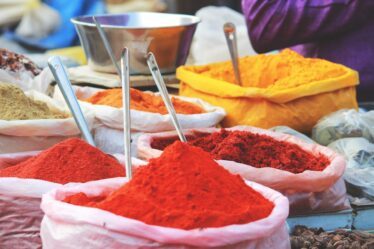
Mexican vanilla is a beloved ingredient in the culinary world, known for its rich and complex flavor profile. It is often considered the gold standard of vanilla, prized for its unique taste and aroma. In this article, we will delve into the fascinating history and origins of Mexican vanilla, explore its distinct flavor profile, discuss the importance of authenticity in vanilla products, and examine the role of terroir in Mexican vanilla production. We will also explore the art of harvesting and curing Mexican vanilla beans, discuss the versatility of Mexican vanilla in culinary applications, and highlight the health benefits of using Mexican vanilla as a natural sweetener. Additionally, we will touch upon sustainability and fair trade practices in Mexican vanilla production, explore the cultural significance of Mexican vanilla in traditional cuisine, and look towards the future of the industry.
Key Takeaways
- Mexican vanilla has a rich history dating back to the Aztecs and is known for its unique flavor profile.
- Authenticity is crucial when purchasing Mexican vanilla products to ensure quality and purity.
- Terroir, or the environmental factors that affect the growth of vanilla beans, plays a significant role in the flavor of Mexican vanilla.
- Harvesting and curing vanilla beans is a delicate process that requires skill and attention to detail.
- Mexican vanilla is versatile and can be used in a variety of culinary applications, and also has health benefits as a natural sweetener.
The History and Origins of Mexican Vanilla
The history of Mexican vanilla dates back thousands of years to the Totonac people of Mexico. The Totonac were the first to discover and cultivate vanilla, considering it a sacred plant with mystical properties. They believed that the god Quetzalcoatl gave them the gift of vanilla and used it in religious ceremonies and rituals.
Vanilla was introduced to Europe by Hernán Cortés, who encountered it during his conquest of Mexico in the 16th century. The Spanish conquistadors were captivated by the exotic flavor and aroma of vanilla and brought it back to Europe, where it quickly gained popularity among royalty and nobility.
Mexican vanilla soon became known as a premium product due to its superior quality and flavor. The warm climate and fertile soil of Mexico provided ideal conditions for growing vanilla orchids, resulting in beans with a rich and complex taste. Today, Mexican vanilla is still highly regarded for its exceptional quality and is sought after by chefs and home cooks around the world.
The Unique Flavor Profile of Mexican Vanilla
The distinct flavor profile of Mexican vanilla can be attributed to its chemical composition. Mexican vanilla beans contain high levels of vanillin, the compound responsible for the characteristic vanilla flavor. However, Mexican vanilla also contains other compounds such as coumarin and heliotropin, which contribute to its unique taste and aroma.
Compared to other varieties of vanilla, Mexican vanilla is often described as having a smooth, creamy, and slightly spicy flavor. It has a deep and complex aroma with hints of caramel, chocolate, and even tobacco. The flavor of Mexican vanilla is well-balanced and lingers on the palate, making it a favorite among chefs and bakers.
The Importance of Authenticity in Mexican Vanilla Products
| Metrics | Values |
|---|---|
| Consumer trust | Increases with authentic Mexican vanilla products |
| Flavor profile | Distinctive and complex in authentic Mexican vanilla products |
| Price | Higher for authentic Mexican vanilla products due to production costs |
| Market demand | Growing for authentic Mexican vanilla products due to increased awareness |
| Production process | More labor-intensive and time-consuming for authentic Mexican vanilla products |
Authenticity is crucial when it comes to Mexican vanilla products. Unfortunately, the market is flooded with counterfeit vanilla products that claim to be Mexican vanilla but are actually made with synthetic vanillin or inferior quality beans. These counterfeit products not only lack the true flavor and aroma of Mexican vanilla but also fail to deliver the health benefits associated with natural vanilla.
Using authentic Mexican vanilla is essential for achieving the true taste and quality in culinary creations. Authentic Mexican vanilla beans are hand-pollinated and carefully cured, resulting in beans that are plump, moist, and full of flavor. By choosing authentic Mexican vanilla products, consumers can ensure they are getting the real deal and supporting the farmers who work hard to produce this exceptional ingredient.
The Role of Terroir in Mexican Vanilla Production
Terroir plays a significant role in the production of Mexican vanilla. The term “terroir” refers to the environmental factors that influence the characteristics of a crop, including climate, soil composition, and geography. In the case of Mexican vanilla, these factors contribute to the unique flavor profile and quality of the beans.
The climate in Mexico is ideal for growing vanilla orchids. The warm temperatures and high humidity create the perfect conditions for the plants to thrive. Additionally, the volcanic soil found in certain regions of Mexico provides essential nutrients for the vanilla plants, resulting in beans with exceptional flavor and aroma.
Certain regions in Mexico are renowned for producing high-quality vanilla. The states of Veracruz and Oaxaca are particularly known for their premium vanilla beans. These regions have a long history of vanilla cultivation and have developed expertise in growing and processing vanilla. The combination of favorable climate, fertile soil, and skilled farmers contributes to the superior quality of Mexican vanilla.
The Art of Harvesting and Curing Mexican Vanilla Beans

The process of harvesting and curing Mexican vanilla beans is labor-intensive and requires great skill and patience. Vanilla orchids are delicate plants that require careful attention throughout their growth cycle.
The first step in the process is hand-pollination. Vanilla orchids are not self-pollinating, so each flower must be pollinated by hand. This involves carefully removing the membrane covering the stigma and transferring pollen from the anther to the stigma using a small stick or toothpick. This meticulous process ensures that each flower produces a vanilla bean.
Once the beans have been harvested, they undergo a curing process to develop their flavor and aroma. The beans are blanched in boiling water to stop the enzymatic process, then fermented and dried over a period of several weeks. This curing process is crucial for developing the complex flavors and aromas that are characteristic of Mexican vanilla.
The Versatility of Mexican Vanilla in Culinary Applications
Mexican vanilla is incredibly versatile and can be used in a wide range of culinary applications. Its rich and complex flavor profile makes it a favorite ingredient among chefs and bakers.
In sweet dishes, Mexican vanilla adds depth and complexity to desserts such as cakes, cookies, ice cream, and custards. It pairs particularly well with chocolate, enhancing its flavor and adding a touch of warmth. Mexican vanilla can also be used in savory dishes, where it adds a subtle sweetness and depth of flavor. It can be used in marinades, sauces, and even in savory spice blends.
The Health Benefits of Using Mexican Vanilla as a Natural Sweetener
In addition to its delicious flavor, Mexican vanilla also offers several health benefits when used as a natural sweetener. Unlike refined sugar, which can cause spikes in blood sugar levels, vanilla has a low glycemic index. This means that it has a minimal impact on blood sugar levels and can be a suitable alternative for those with diabetes or those looking to reduce their sugar intake.
Furthermore, vanilla contains antioxidants, which help protect the body against oxidative stress and inflammation. These antioxidants have been linked to various health benefits, including improved heart health and reduced risk of chronic diseases.
The Sustainability and Fair Trade Practices in Mexican Vanilla Production
The vanilla industry faces several challenges when it comes to sustainability and fair trade practices. Vanilla is a labor-intensive crop that requires manual pollination and careful curing. However, the demand for vanilla has skyrocketed in recent years, leading to increased pressure on farmers and workers.
Many vanilla farmers struggle to make a living wage due to fluctuating market prices and the high cost of production. Additionally, the vanilla industry is vulnerable to climate change, with extreme weather events and diseases affecting crop yields.
Efforts are being made to promote sustainable and ethical practices in the vanilla industry. Organizations such as Fairtrade International work to ensure that farmers receive fair prices for their products and have access to resources and support. Additionally, initiatives are underway to promote sustainable farming practices that protect the environment and preserve biodiversity.
The Cultural Significance of Mexican Vanilla in Traditional Cuisine
Vanilla holds great cultural significance in Mexican cuisine and indigenous traditions. In Mexico, vanilla is used in a wide range of traditional dishes, from sweet desserts to savory sauces. It is an essential ingredient in Mexican hot chocolate, adding a warm and comforting flavor to the beverage.
Vanilla also plays a role in celebrations and rituals in Mexican culture. It is often used in traditional sweets and desserts that are served during holidays and special occasions. Additionally, vanilla is believed to have aphrodisiac properties and is sometimes used in love potions and rituals.
The Future of Mexican Vanilla: Trends and Innovations in the Industry
The future of Mexican vanilla looks promising, as there is a growing demand for natural and authentic vanilla products. Consumers are becoming more conscious of the ingredients they use and are seeking out high-quality, sustainably sourced products.
Innovation in the vanilla industry is also on the rise. New technologies are being developed to improve the efficiency of vanilla production and reduce the labor-intensive nature of the process. Additionally, there is a focus on sustainable farming practices that minimize the environmental impact of vanilla cultivation.
Mexican vanilla is a true culinary treasure, known for its exceptional flavor and aroma. Its rich history, unique flavor profile, and cultural significance make it a beloved ingredient in both traditional and modern cuisine. By seeking out authentic Mexican vanilla products and supporting sustainable and ethical practices in the industry, consumers can ensure they are getting the best quality vanilla while also making a positive impact on the lives of farmers and workers. So next time you reach for a bottle of vanilla extract or sprinkle some vanilla beans into your recipe, remember the fascinating journey that brought this extraordinary ingredient to your kitchen.
If you’re a fan of the rich and aromatic Mexican vanilla flavor, you’ll definitely want to check out this article on Flavorful Sips. They have a fascinating piece on the symphony of Sharbat, exploring the top flavors to try in this refreshing drink. From floral notes to fruity undertones, it’s a delightful journey for your taste buds. And while you’re there, don’t miss their other articles like “Mastering Mote con Huesillo: A Step-by-Step Guide” and “Coquito Recipe: Make Your Own.” With Flavorful Sips, you’ll discover a world of delicious flavors and exciting recipes. So click here to explore more!



